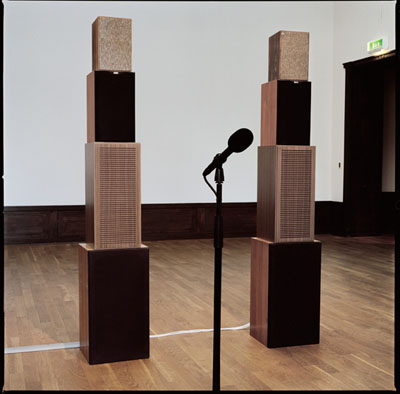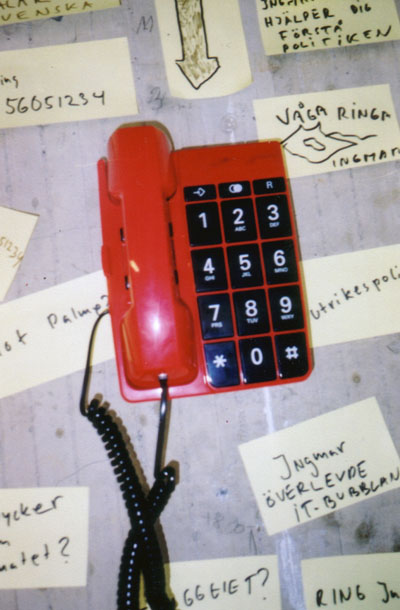 |
[August 15th 2005]

Nils Claesson.
10*10
10 questions for 10 Nordic artists.
Current artist:
Nils Claesson.
Artificial sets out to dig an alternative route through the activities on the Nordic scene for computer based art. We wanted to find a way to sidestep the restrictions in our own particular outlook so we are therefore launching an unpredictable series of interviews, which will hopefully help us uncover the hidden potentials out there.
Initially we handed Norwegian artist Trine Eidsmo a set of 10 questions and she passed them on to an artist of her choice. After answering the same questions, this artist chooses a new artist ... and so forth. The only criterion for the participants are that they live and work in Scandinavia and create computer based art. In the end, 10 Nordic artists will have answered 10 questions about their art, working process and much more.
Trine chose to pass the questions on to Swedish artist Nils Claesson. Nils is a new media artist from Sweden. He also participated in the establishment of the media lab CRAC (creative room for art and computing, www.crac.org) and was head of the lab in 2002-2005 and manager of PNEK (Production Network for Electronic Art, www.pnek.no) from 2001 to 2002. He is very active in Eastern Europe and is one of the initiators of the RAM project (Re-approaching New Media).
Here is what he wrote:
What is your background?
I have been working as an artist for 15 years. Before I have experience from media and also radical politics. I have also made films: animations and documentaries.
Describe your working process.
I spend a lot of time Thai boxing and on my bicycle - usually I get the best ideas doing sports. I am a freelancer and my living depends on if I can interest some kind of financer/sponsor/customer in my work. It means that a lot of projects begin as written applications to different funds and institutions. Ok, I would say that a lot of things start with writing and making drawings and models. The ideal situation is if somebody (with money) phones and wants a piece of art. My phone-number is +46 70 632 93 69.
Do you solve your technical issues yourself (do you e.g. program yourself) or do you rely on the cooperation with a programmer or a technician?
It depends on the piece. When I make electronic art that is to be exhibited for a long time in a public space usually I work with both programmers and technicians to ensure that the things will be reliable and work. One big weakness of techno art is when the things do not work and make the audience and the critique disappointed. Usually I like to create a team around a project. It's like building a rocket to go to mars. You don't do it only by yourself.

From Nils Claesson's Ingmar project.
Ingmar is a voice-controlled interface that answers questions about various topics. The project is a cooperation with programmer
Rolf Lindgren.
In which way do you describe your art?
One of my last pieces was described as relational esthetics by a leading art critic in Sweden's biggest daily paper. They are relational in the meaning that most of my work is directed to an audience and I want the audience to participate in my work in one way or the other. I have made interfaces for people to protest by making a hunger strike, donate things to the future, talk about economy, politics, art with an artificial intelligence or reflect over how we humans describe the sounds of dogs.
How would you describe the relation between computer based art forms and the traditional art forms?
On one hand: Just because a lot of artists have a computer in there studio nowadays it does not make them computer artists. On the other hand: Programming is not an art, it is a high advanced skill. Sometimes it seems to be a lack of understanding for contemporary art and its traditions among computer artists. They tend to talk about art in a way people talked about art before Kant. They should start reading books. I think that computer art works very well in a mixed situation together with more traditional art expressions. A show with only computer arts tends to look like a showroom for a computer sales store.
Which role should art institutions and galleries play in regards to work like yours?
They should show it.
Which exhibition form do you regard as ideal for your art?
I like to do things in public space and electronic public space. A piece that worked very well was called: Talk politics with Ingmar. It was an interface that the audience could reach by mobile phones. During a month over 1300 people phoned Ingmar and had a political conversation with an artificial intelligence. Ingmar had to give interviews to the radio and newspapers.

From Nils Claesson's Ingmar project. Ingmar is a voice-controlled interface that answers questions about various topics. The project is a cooperation with programmer
Rolf Lindgren.
How would you describe the situation on the Nordic scene for computer based art?
In Finland they have Kiasma that is a perfect venue for this kind of art. In Finland you also have a great tradition from Mu mediabase to Katastro.fi and m-cult mm. The Finns are god. In Norway they have a generous funding system channeling money directly to electronic arts. The problem in Norway is that the scene is too dependent on state funding. But they have places like BEK in Bergen and TEKS in Trondheim. The most vital part of the computer based art scene in Norway seems to be the acoustic scene.
In Sweden the big state funding disappeared with the dot com economy. Places like Electrohype and Splintermind are closing down and most people working with computer based art are trying to be a part of the contemporary art scene. But all the art academies have computer departments and you also have institutions like the Interactive Institute hiring computer artists to be part of different projects.
Denmark is unknown for me when it comes to computer based art but if they could channel some of the energy they have in the film scene in to computer arts things could go wild.
To sum up it is a lot of complains coming all the times from Nordic computer artists. (Artists just love to complain. We could build a Nordic Virtual Complaining Wall.) To be honest computers are cheap, we have the internet, what are stopping the computer artists?
How do you support yourself financially as a digital artist?
I do a lot of different things. I teach. I lecture. I make work for others. I get grants and project money. I would love to sell my work more. I should find myself a gallery.
What are you working on now?
For the moment I am working on a big project about the sexualisation of electronic public space together with a friend Karin Hansson. I am also making an animated film about snow and I am also involved in building a small new media centre in Minsk Belarus. I have to learn Russian. That is one of my plans.
|
 |
|